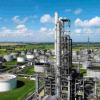|
|
Heat Exchanger Bypass Control Sizing
Started by sundeep gupta, Nov 13 2008 01:46 PM
3 replies to this topic
Share this topic:
#1

Posted 13 November 2008 - 01:46 PM
There are heat exchangers (S/T), where the fluid temperature of hot fluid is controlled using a bypass CV (CV1) across the exchanger as well as a CV (CV2) which is in series with the exchanger.
My question is, that what should be the methodology of sizing the bypass CV1? It's pressure drop will be the pressure-drop across the HE and the CV2(in series with HE).
Can somebody post a reply to this?
thanks and regards
Sundeep
#2

Posted 13 November 2008 - 02:03 PM
Hi Sundeep,
Yes, the by-pass CV1 should be sized for 25% of total flow for a pressure drop equal to the pressure drop across heat exchanger plus CV2 (exchanger and CV2 dP corresponding to 75% of total flow). The exchanger should be designed for 110-120% flow. This design will make exchanger more flexible in controlling temperature during offset cases.
Thanks,
S. Biswas
Yes, the by-pass CV1 should be sized for 25% of total flow for a pressure drop equal to the pressure drop across heat exchanger plus CV2 (exchanger and CV2 dP corresponding to 75% of total flow). The exchanger should be designed for 110-120% flow. This design will make exchanger more flexible in controlling temperature during offset cases.
Thanks,
S. Biswas
QUOTE (sundeep gupta @ Nov 13 2008, 01:46 PM) <{POST_SNAPBACK}>
There are heat exchangers (S/T), where the fluid temperature of hot fluid is controlled using a bypass CV (CV1) across the exchanger as well as a CV (CV2) which is in series with the exchanger.
My question is, that what should be the methodology of sizing the bypass CV1? It's pressure drop will be the pressure-drop across the HE and the CV2(in series with HE).
Can somebody post a reply to this?
thanks and regards
Sundeep
My question is, that what should be the methodology of sizing the bypass CV1? It's pressure drop will be the pressure-drop across the HE and the CV2(in series with HE).
Can somebody post a reply to this?
thanks and regards
Sundeep
#3

Posted 13 November 2008 - 06:22 PM
25% of total flow could be a good start...
Shall always make sure this bypass control valve allow flowrate for all other non-design cases i.e. turndown, different feed composition, different campaign or operating mode, etc
Shall always make sure this bypass control valve allow flowrate for all other non-design cases i.e. turndown, different feed composition, different campaign or operating mode, etc
#4

Posted 13 November 2008 - 10:08 PM
Sundeep,
Really the sizing of the bypass valve depends on how much flexibility you want. Might you ever want to bypass 100% of the hot fluid flow? This might be desired if you had several exchangers in series. Then, perhaps in winter, the other exchangers could provide all the cooling you'd need, and it might be desirable to completely bypass this exchanger. If that is true, then size CV1 for 100% of the flowrate. Just decide the maximum bypass flow you'd want and size accordingly. Only you and others knowledgable about your process and design can determine this.
Really the sizing of the bypass valve depends on how much flexibility you want. Might you ever want to bypass 100% of the hot fluid flow? This might be desired if you had several exchangers in series. Then, perhaps in winter, the other exchangers could provide all the cooling you'd need, and it might be desirable to completely bypass this exchanger. If that is true, then size CV1 for 100% of the flowrate. Just decide the maximum bypass flow you'd want and size accordingly. Only you and others knowledgable about your process and design can determine this.
Similar Topics
Guidance On Sizing Jacketed Pipe For Glycerine CoolingStarted by Guest_Kentucky08_* , 28 Jun 2025 |
|

|
||
Parallel Control Valves Downstream Relief ScenarioStarted by Guest_pklavinsJ_* , 18 Jun 2025 |
|

|
||
Separator Sizing Step By Step ProcedureStarted by Guest_krishnamurthy_* , 06 Apr 2023 |
|

|
||
Level Control ValveStarted by Guest_Ilyes_* , 03 Jun 2025 |
|

|
||
Steam Pressure In Heat ExchangerStarted by Guest_mvanrijnbach_* , 15 Apr 2025 |
|

|

 FB
FB







